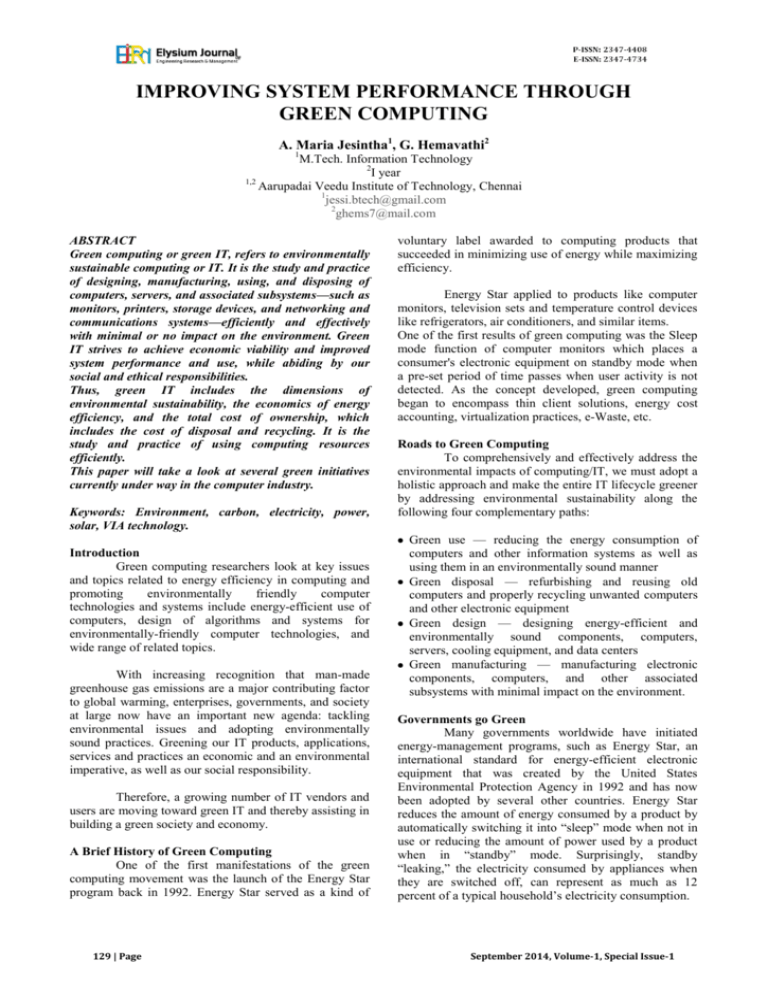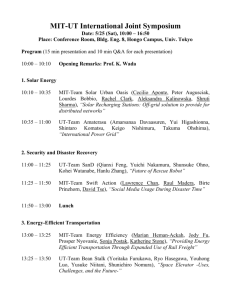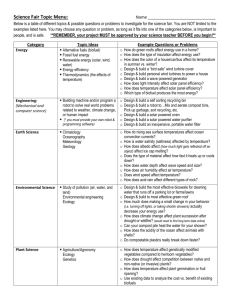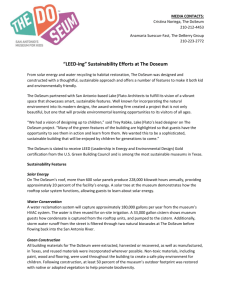Green computing
advertisement

IMPROVING SYSTEM PERFORMANCE THROUGH GREEN COMPUTING A. Maria Jesintha1, G. Hemavathi2 1 M.Tech. Information Technology 2 I year 1,2 Aarupadai Veedu Institute of Technology, Chennai 1 jessi.btech@gmail.com 2 ghems7@mail.com ABSTRACT Green computing or green IT, refers to environmentally sustainable computing or IT. It is the study and practice of designing, manufacturing, using, and disposing of computers, servers, and associated subsystems—such as monitors, printers, storage devices, and networking and communications systems—efficiently and effectively with minimal or no impact on the environment. Green IT strives to achieve economic viability and improved system performance and use, while abiding by our social and ethical responsibilities. Thus, green IT includes the dimensions of environmental sustainability, the economics of energy efficiency, and the total cost of ownership, which includes the cost of disposal and recycling. It is the study and practice of using computing resources efficiently. This paper will take a look at several green initiatives currently under way in the computer industry. Keywords: Environment, carbon, electricity, power, solar, VIA technology. Introduction Green computing researchers look at key issues and topics related to energy efficiency in computing and promoting environmentally friendly computer technologies and systems include energy-efficient use of computers, design of algorithms and systems for environmentally-friendly computer technologies, and wide range of related topics. With increasing recognition that man-made greenhouse gas emissions are a major contributing factor to global warming, enterprises, governments, and society at large now have an important new agenda: tackling environmental issues and adopting environmentally sound practices. Greening our IT products, applications, services and practices an economic and an environmental imperative, as well as our social responsibility. Therefore, a growing number of IT vendors and users are moving toward green IT and thereby assisting in building a green society and economy. A Brief History of Green Computing One of the first manifestations of the green computing movement was the launch of the Energy Star program back in 1992. Energy Star served as a kind of 129 | Page voluntary label awarded to computing products that succeeded in minimizing use of energy while maximizing efficiency. Energy Star applied to products like computer monitors, television sets and temperature control devices like refrigerators, air conditioners, and similar items. One of the first results of green computing was the Sleep mode function of computer monitors which places a consumer's electronic equipment on standby mode when a pre-set period of time passes when user activity is not detected. As the concept developed, green computing began to encompass thin client solutions, energy cost accounting, virtualization practices, e-Waste, etc. Roads to Green Computing To comprehensively and effectively address the environmental impacts of computing/IT, we must adopt a holistic approach and make the entire IT lifecycle greener by addressing environmental sustainability along the following four complementary paths: Green use — reducing the energy consumption of computers and other information systems as well as using them in an environmentally sound manner Green disposal — refurbishing and reusing old computers and properly recycling unwanted computers and other electronic equipment Green design — designing energy-efficient and environmentally sound components, computers, servers, cooling equipment, and data centers Green manufacturing — manufacturing electronic components, computers, and other associated subsystems with minimal impact on the environment. Governments go Green Many governments worldwide have initiated energy-management programs, such as Energy Star, an international standard for energy-efficient electronic equipment that was created by the United States Environmental Protection Agency in 1992 and has now been adopted by several other countries. Energy Star reduces the amount of energy consumed by a product by automatically switching it into ―sleep‖ mode when not in use or reducing the amount of power used by a product when in ―standby‖ mode. Surprisingly, standby ―leaking,‖ the electricity consumed by appliances when they are switched off, can represent as much as 12 percent of a typical household’s electricity consumption. September 2014, Volume-1, Special Issue-1 In Australia, standby power is a primary factor for the country’s increased greenhouse gas emissions — more than 5 megatons (CO2 equivalent) annually. Worldwide, standby power is estimated to account for as much as 1 percent of global greenhouse emissions. Most of the energy used by products on standby does not result any useful function. A small amount can be needed for maintaining memory or an internal clock, remote-control activation, or other features; but most standby power is wasted energy. Energy Star–enabled products minimize this waste. Approaches to Green Computing (a) Algorithmic efficiency The efficiency of algorithms has an impact on the amount of computer resources required for any given computing function and there are many efficiency tradeoffs in writing programs. As computers have become more numerous and the cost of hardware has declined relative to the cost of energy, the energy efficiency and environmental impact of computing systems and programs has received increased attention. A study by Alex Wissner-Gross, a physicist at Harvard, estimated that the average Google search released 7 grams of carbon dioxide (CO₂ ). However, Google disputes this figure, arguing instead that a typical search produces only 0.2 grams of CO₂ . (b) Power management The Advanced Configuration and Power Interface (ACPI), an open industry standard, allows an operating system to directly control the power saving aspects of its underlying hardware. This allows a system to automatically turn off components such as monitors and hard drives after set periods of inactivity. In addition, a system may hibernate, where most components (including the CPU and the system RAM) are turned off. ACPI is a successor to an earlier Intel-Microsoft standard called Advanced Power Management, which allows a computer's BIOS to control power management functions. Some programs allow the user to manually adjust the voltages supplied to the CPU, which reduces both the amount of heat produced and electricity consumed. This process is called undervolting. Some CPUs can automatically undervolt the processor depending on the workload; this technology is called "SpeedStep" on Intel processors, "PowerNow!"/"Cool'n'Quiet" on AMD chips, LongHaul on VIA CPUs, and LongRun with Transmeta processors. Recently a computer activity and putting computers into power saving mode if they are idle. 1000 PC and more can be admisitered very easily resulting in energy consumption reduction of 40 - 80%. (c) Storage 130 | Page Smaller form factor (e.g. 2.5 inch) hard disk drives often consume less power per gigabyte than physically larger drives. Unlike hard disk drives, solidstate drives store data in flash memory or DRAM. With no moving parts, power consumption may be reduced somewhat for low capacity flash based devices. Even at modest sizes, DRAM-based SSDs may use more power than hard disks, (e.g., 4GB i-RAM uses more power and space than laptop drives). Though most flash based drives are generally slower for writing than hard disks. In a recent case study Fusion-io, manufacturers of the world's fastest Solid State Storage devices, managed to reduce the carbon footprint and operating costs of MySpace data centers by 80% while increasing performance speeds beyond that which is was attainable by multiple hard disk drives in Raid 0. In response, MySpace was able to permanently retire several of their servers, including all heavy-load servers, further reducing their carbon footprint. (d) Display LCD monitors typically use a cold-cathode fluorescent bulb to provide light for the display. Some newer displays use an array of light-emitting diodes (LEDs) in place of the fluorescent bulb, which reduces the amount of electricity used by the display.[32] (e) Operating system issues Microsoft has been heavily critizied for producing operating systems that, out of the box, are not energy efficient. Due to Microsoft's dominance of the huge desktop operating system market this may have resulted in more energy waste than any other initiative by other vendors. Microsoft claim to have improved this in Vista, though the claim is disputed.This problem has been compounded because Windows versions before Vista did not allow power management features to be configured centrally by a system administrator. This has meant that most organisations have been unable to improve this situation. Again, Microsoft Windows Vista has improved this by adding basic central power management configuration. The basic support offered has been unpopular with system administrators who want to change policy to meet changing user requirements or schedules. Several software products have been developed to fill this gap including Auto Shutdown Manager,Data Synergy PowerMAN, Faronics Power Save, 1E NightWatchman, Verdiem Surveyor/Edison, Verismic Power Manager, WakeupOnStandBy (WOSB), TOff and Greentrac (also promotes behavioral change) among others. (f) Materials recycling Computer systems that have outlived their particular function can be repurposed, or donated to various charities and non-profit organizations. However, many charities have recently imposed minimum system requirements for donated equipment. Additionally, parts from outdated systems may be September 2014, Volume-1, Special Issue-1 salvaged and recycled through certain retail outlets and municipal or private recycling centers. Recycling computing equipment can keep harmful materials such as lead, mercury, and hexavalent chromium out of landfills, but often computers gathered through recycling drives are shipped to developing countries where environmental standards are less strict than in North America and Europe.The Silicon Valley Toxics Coalition estimates that 80% of the post-consumer e-waste collected for recycling is shipped abroad to countries such as China and Pakistan. VIA Technologies Green Computing VIA Technologies, a Taiwanese company that manufactures motherboard chipsets, CPUs, and other computer hardware, introduced its initiative for "green computing" in 2001. With this green vision, the company has been focusing on power efficiency throughout the design and manufacturing process of its products. Its environmentally friendly products are manufactured using a range of clean-computing strategies, and the company is striving to educate markets on the benefits of green computing for the sake of the environment, as well as productivity and overall user experience. (a) Carbon-free computing One of the VIA Technologies’ ideas is to reduce the "carbon footprint" of users — the amount of greenhouse gases produced, measured in units of carbon dioxide (CO2). Greenhouse gases naturally blanket the Earth and are responsible for its more or less stable temperature. An increase in the concentration of the main greenhouse gases — carbon dioxide, methane, nitrous oxide, and fluorocarbons — is believed to be responsible for Earth's increasing temperature, which could lead to severe floods and droughts, rising sea levels, and other environmental effects, affecting both life and the world's economy. After the 1997 Kyoto Protocol for the United Nations Framework Convention on Climate Change, the world has finally taken the first step in reducing emissions. The emissions are mainly a result of fossilfuel-burning power plants. (In the United States, such electricity generation is responsible for 38 percent of the country’s carbon dioxide emissions.)In addition, VIA promotes the use of such alternative energy sources as solar power, so power plants wouldn't need to burn as much fossil fuels, reducing the amount of energy used. Wetlands also provide a great service in sequestering some of the carbon dioxide emitted into the atmosphere. Although they make up only 4 to 6 percent of the Earth's landmass, wetlands are capable of absorbing 20 to 25 percent of the atmospheric carbon dioxide. VIA is working closely with organizations responsible for preserving wetlands and other natural habitats, and others who support extensive recycling programs for ICT equipment. The amount paid to these organizations will be represented by a proportion of the carbon-free product’s price. 131 | Page Carbon-emissions control has been a key issue for many companies who have expressed a firm commitment to sustainability. Dell is a good example of a company with a green image, known for its free worldwide product-recycling program. Dell’s Plant a Tree for Me project allows customers to offset their carbon emissions by paying an extra $2 to $4, depending on the product purchased. AMD, a global microprocessor manufacturer, is also working toward reducing energy consumption in its products, cutting back on hazardous waste and reducing its eco-impact. The company’s use of silicon-on-insulator (SOI) technology in its manufacturing, and strained silicon capping films on transistors (known as ―dual stress liner‖ technology), have contributed to reduced power consumption in its products. (b) Solar Computing Amid the international race toward alternativeenergy sources, VIA is setting its eyes on the sun, and the company's Solar Computing initiative is a significant part of its green-computing projects. Solar powered computing For that purpose VIA partnered with Motech Industries, one of the largest producers of solar cells worldwide. Solar cells fit VIA are power-efficient silicon, platform, and system technologies and enable the company to develop fully solar-powered devices that are nonpolluting, silent, and highly reliable. Solar cells require very little maintenance throughout their lifetime, and once initial installation costs are covered, they provide energy at virtually no cost. Worldwide production of solar cells has increased rapidly over the last few years; and as more governments begin to recognize the benefits of solar power, and the development of photovoltaic technologies goes on, costs are expected to continue to decline. As part of VIA's ―pc-1‖ initiative, the company established the first-ever solar-powered cyber community center in the South Pacific, powered entirely by solar technology. (c) Energy-efficient computing A central goal of VIA’s green-computing initiative is the development of energy-efficient platforms for low-power, small-form-factor (SFF) computing devices. In 2005, the company introduced the VIA C7-M and VIA C7 processors that have a maximum power consumption of 20W at 2.0GHz and an average power consumption of 1W. These energy-efficient processors produce over four times less carbon during their operation and can be efficiently embedded in solar-powered devices. September 2014, Volume-1, Special Issue-1 VIA isn’t the only company to address environmental concerns: Intel, the world's largest semiconductor maker, revealed eco-friendly products at a recent conference in London. The company uses virtualization software, a technique that enables Intel to combine several physical systems into a virtual machine that runs on a single, powerful base system, thus significantly reducing power consumption. Earlier this year, Intel joined Google, Microsoft, and other companies in the launch of the Climate Savers Computing Initiative that commits businesses to meet the Environmental Protection Agency’s Energy Star guidelines for energyefficient devices. On the horizon Green technology is gaining more and more public attention through the work of environmental organizations and government initiatives. VIA is one of the first corporations to concentrate on green computing that seems less a passing trend than a first step toward significant changes in technology. In May 2007, IBM unveiled its Project Big Green, dedicated to increasing energy efficiency across the company's branches around the world. Experts say that businesses will continue to invest in clean computing, not only because of future regulations, policies, and social demands to reduce their carbon footprint, but also due to the significant long-term savings it can make. Several companies are already headfirst into the green-computing business. Located in the Silicon Valley and founded in 2006, Zonbu was the first company to introduce a completely environmentally responsible computer - Their "Zonbox" computer is a carbonemission neutral computer, thanks to a low-power design and regulatory-grade carbon offsets. The device, which complies both to Energy Star standards and the Restriction of Hazardous Substances Directive (RoHS), consumes only 15W, compared to the 175W consumed by a typical desktop PC. Zonbu also provides a free takeback program to minimize environmental e-waste. Conclusion So Green computing is a mindset that asks how we can satisfy the growing demand for network computing without putting such pressure on the environment. There is an alternative way to design a processor and a system such that we don't increase demands on the environment, but still provide an increased amount of processing capability to customers to satisfy their business needs. Green computing is not about going out and designing biodegradable packaging for products. Now the time came to think about the efficiently use of computers and the resources which are non renewable. It opens a new window for the new entrepreneur for harvesting with E-waste material and scrap computers. References 1. San Murugesan,"Going Green with IT: You’re Responsibility toward Environmental Sustainability." Cutter Consortium Business-IT Strategies Executive Report, Vol. 10, No. 8, August 2007. 2. http://greensoda.cs.berkeley.edu/wiki/index.php/Deskto p, 3. http://www.itpowersaving.com 4. http://www.greenIT-conferences.org 5. ‖The common sense of lean and green IT" Zonbu’s Zonbox 132 | Page September 2014, Volume-1, Special Issue-1








